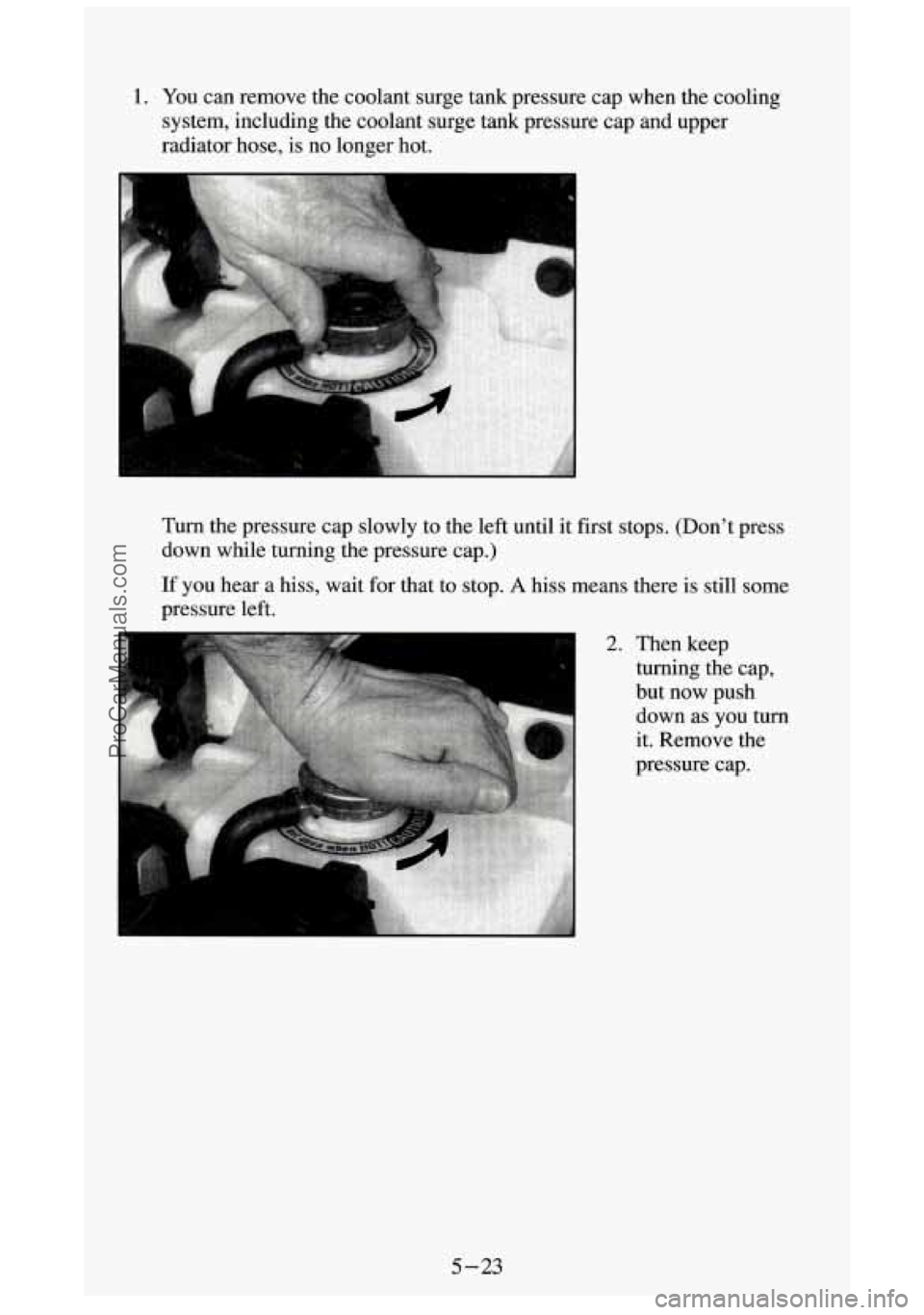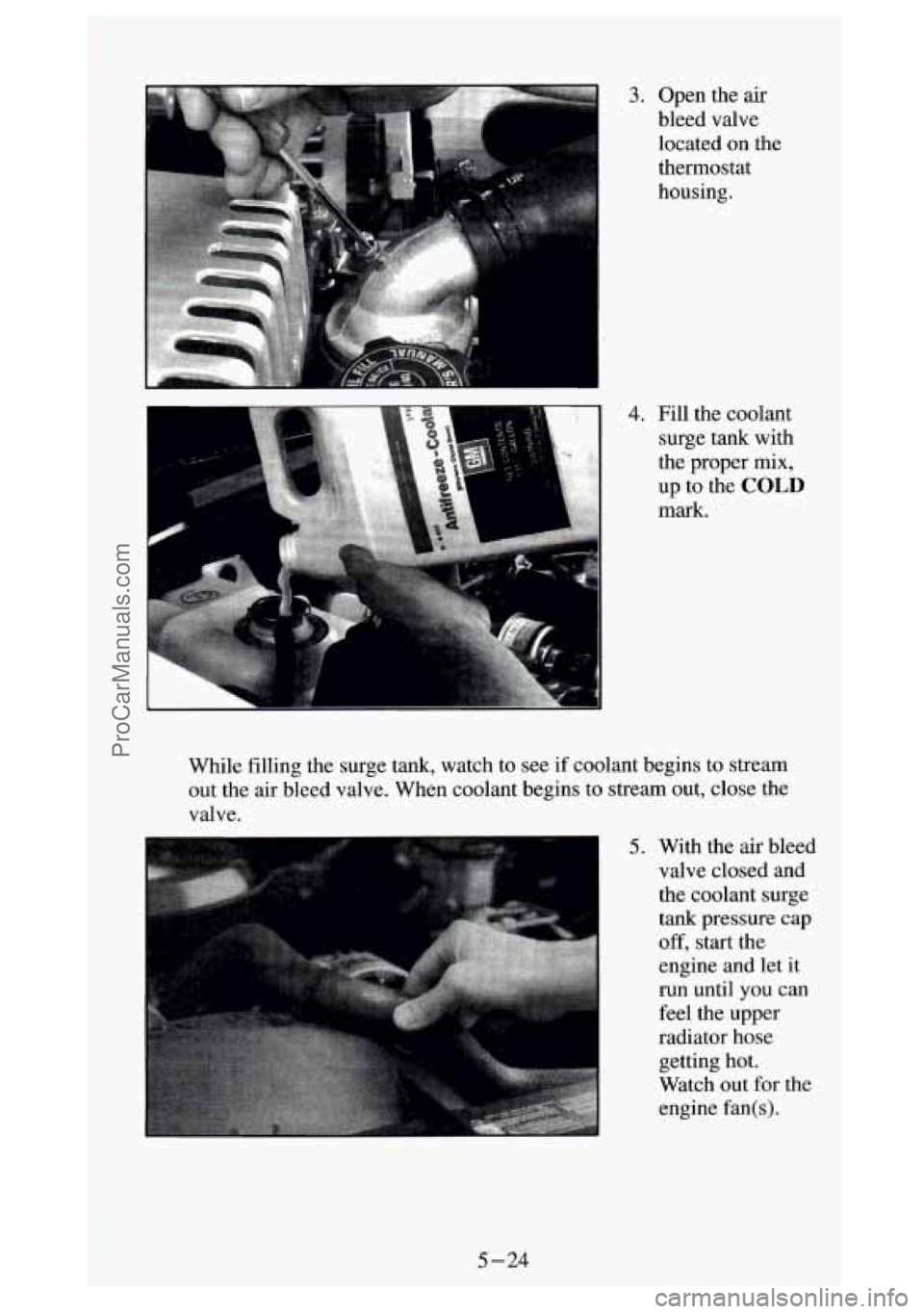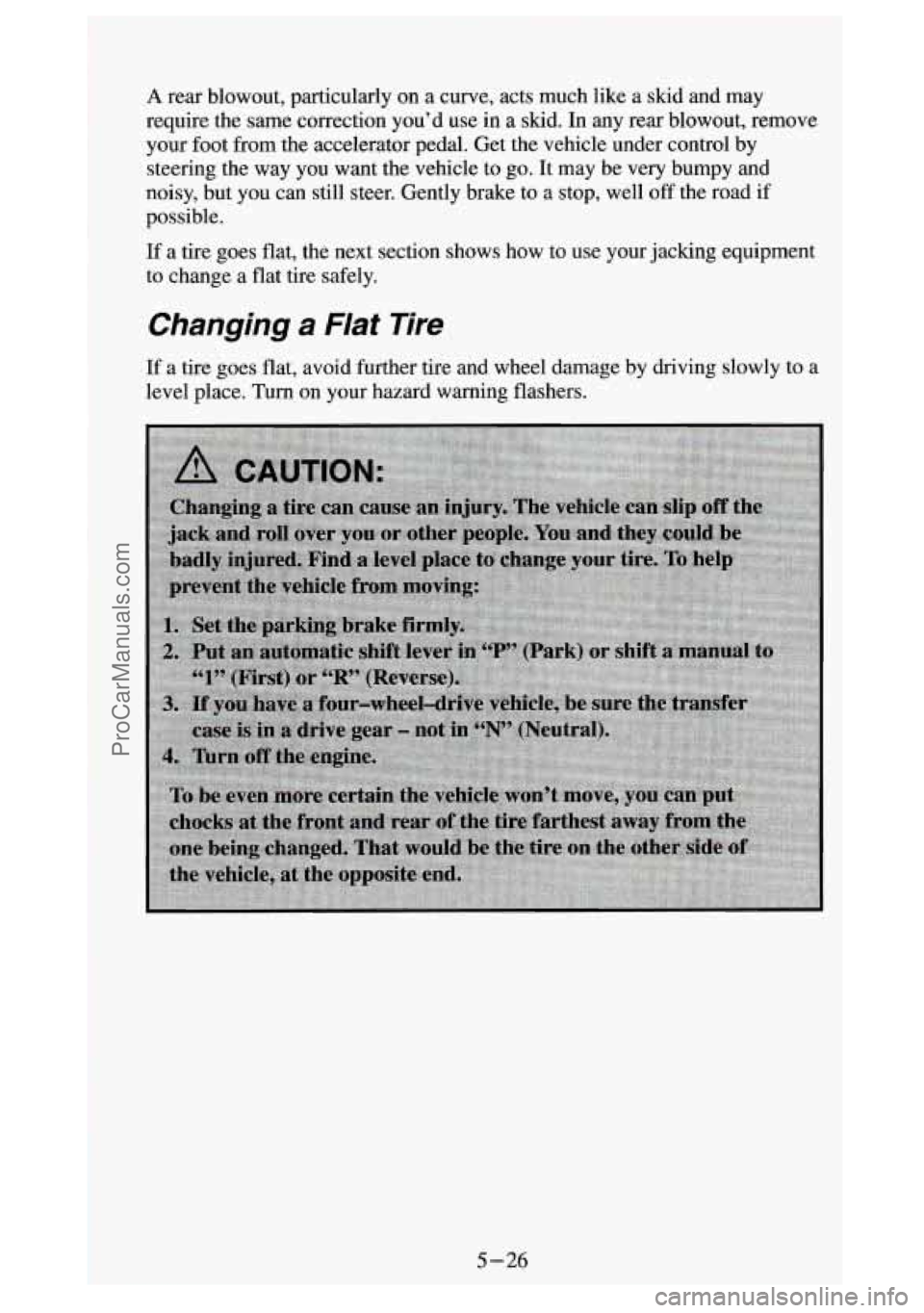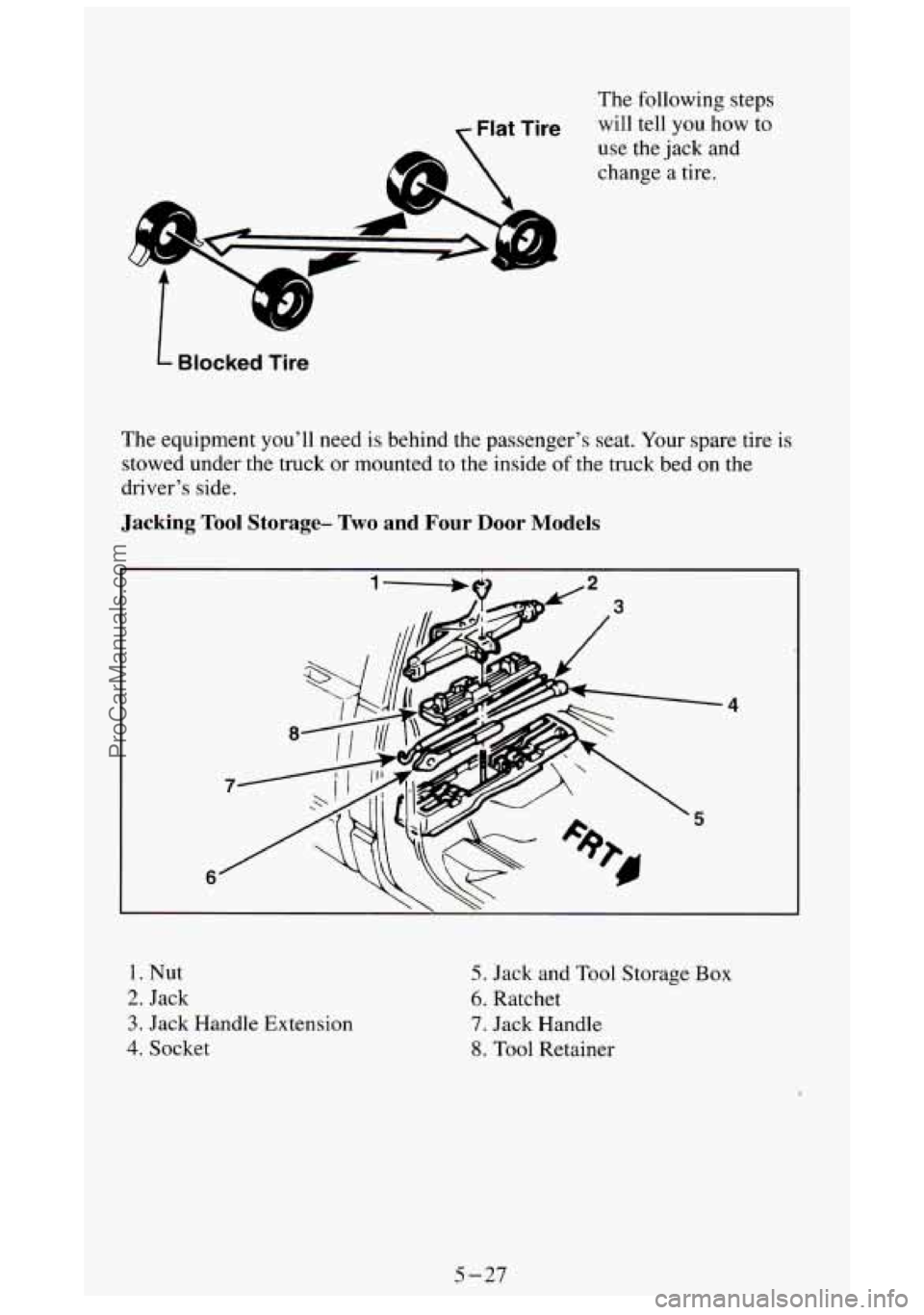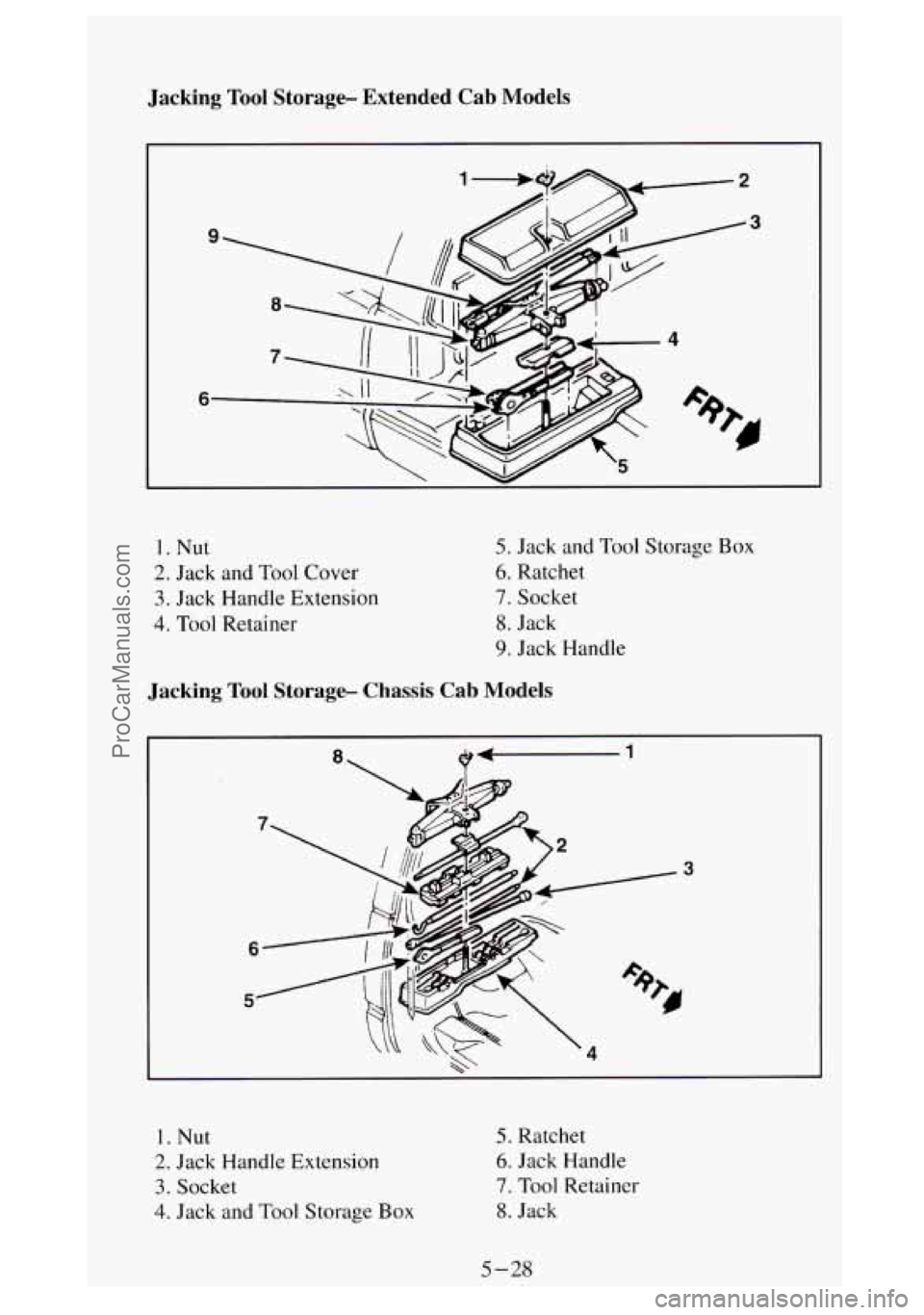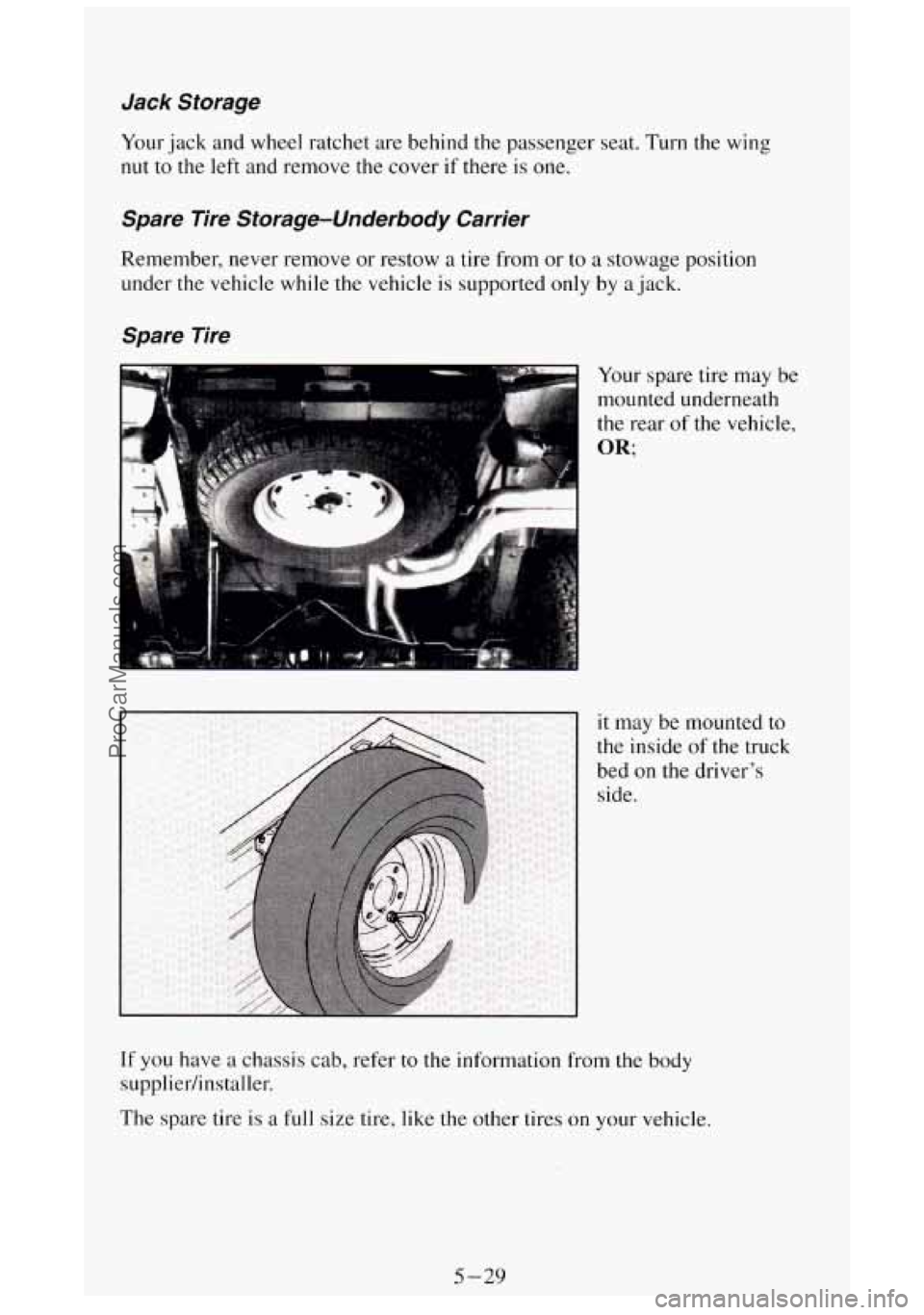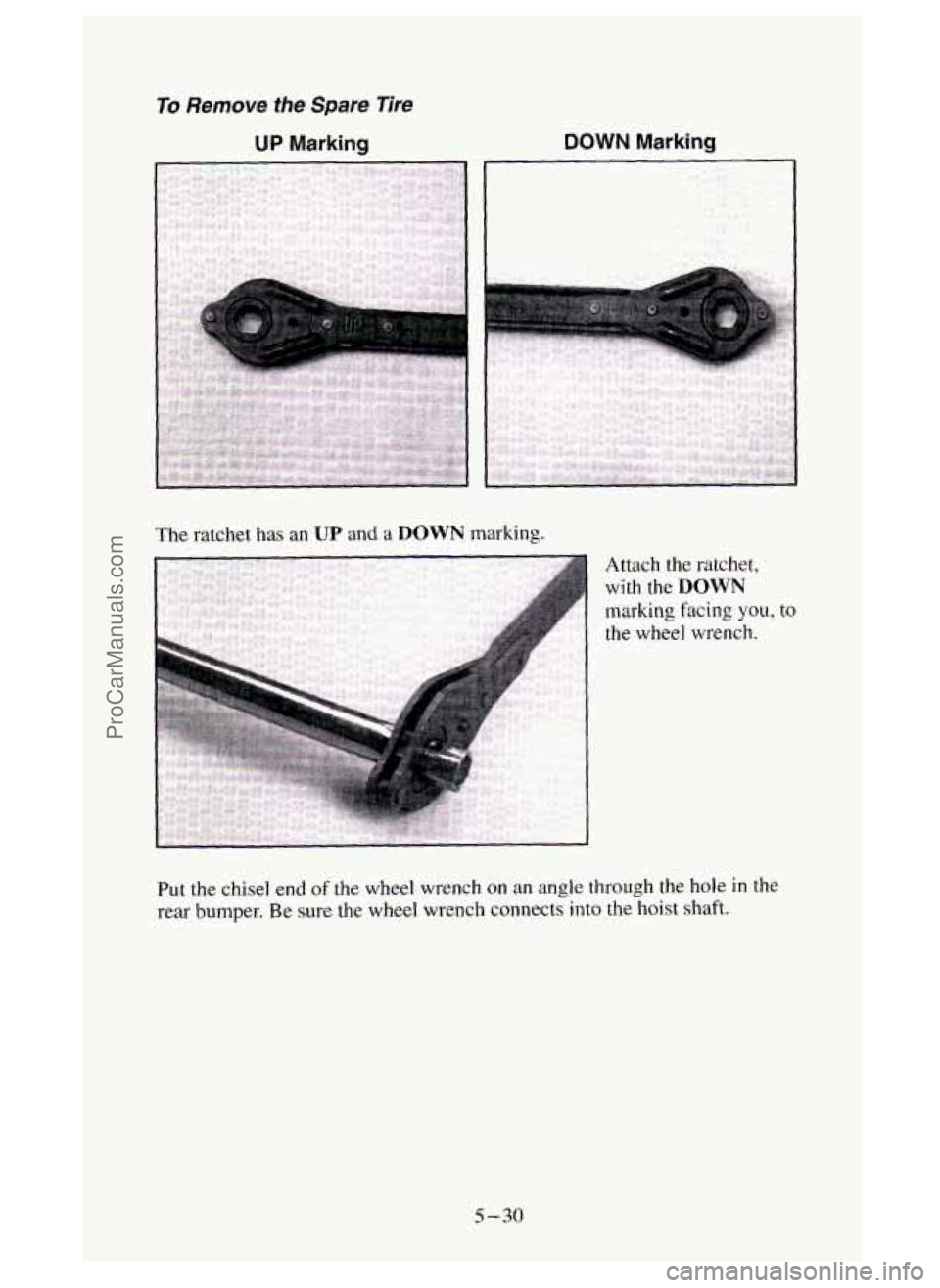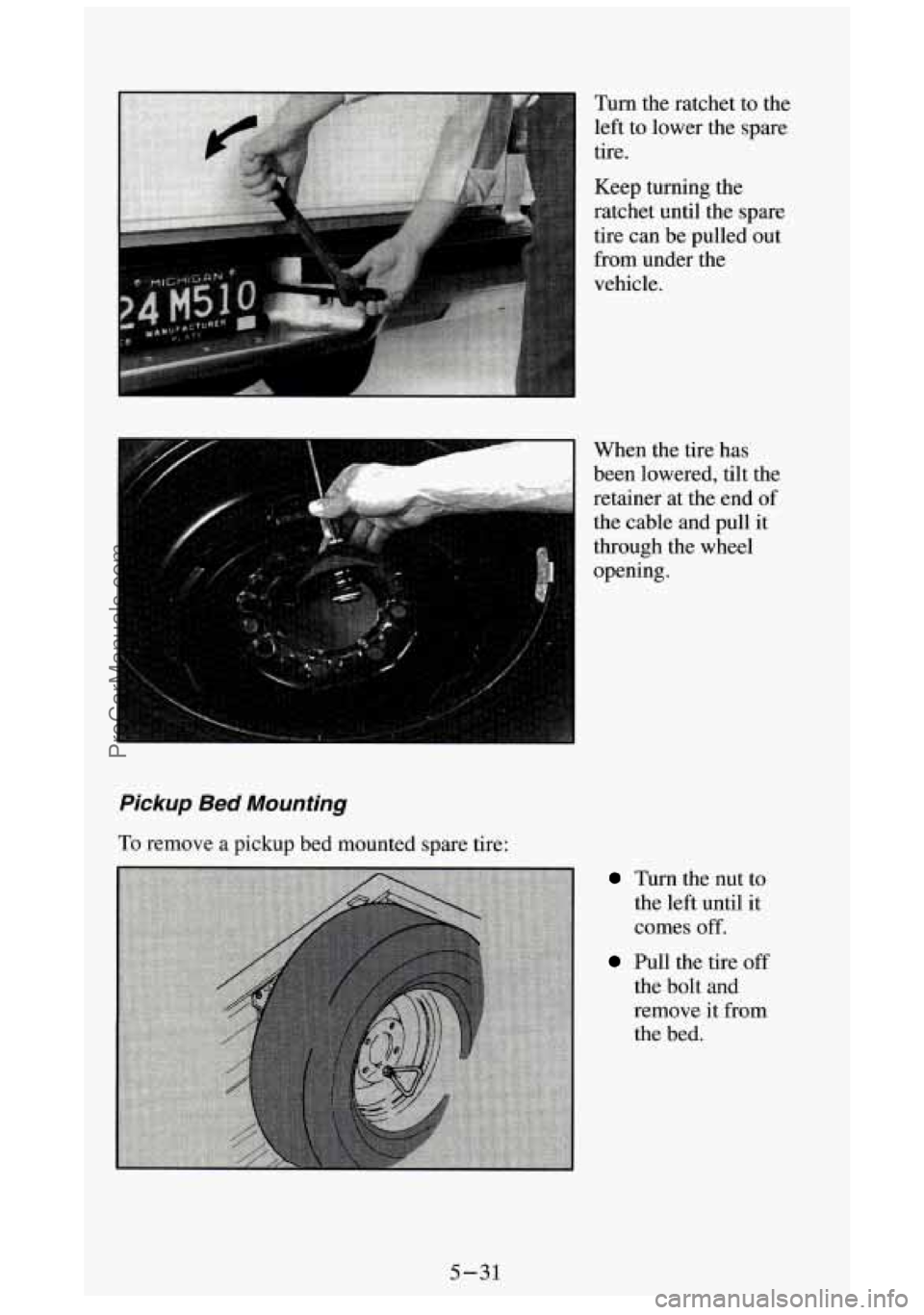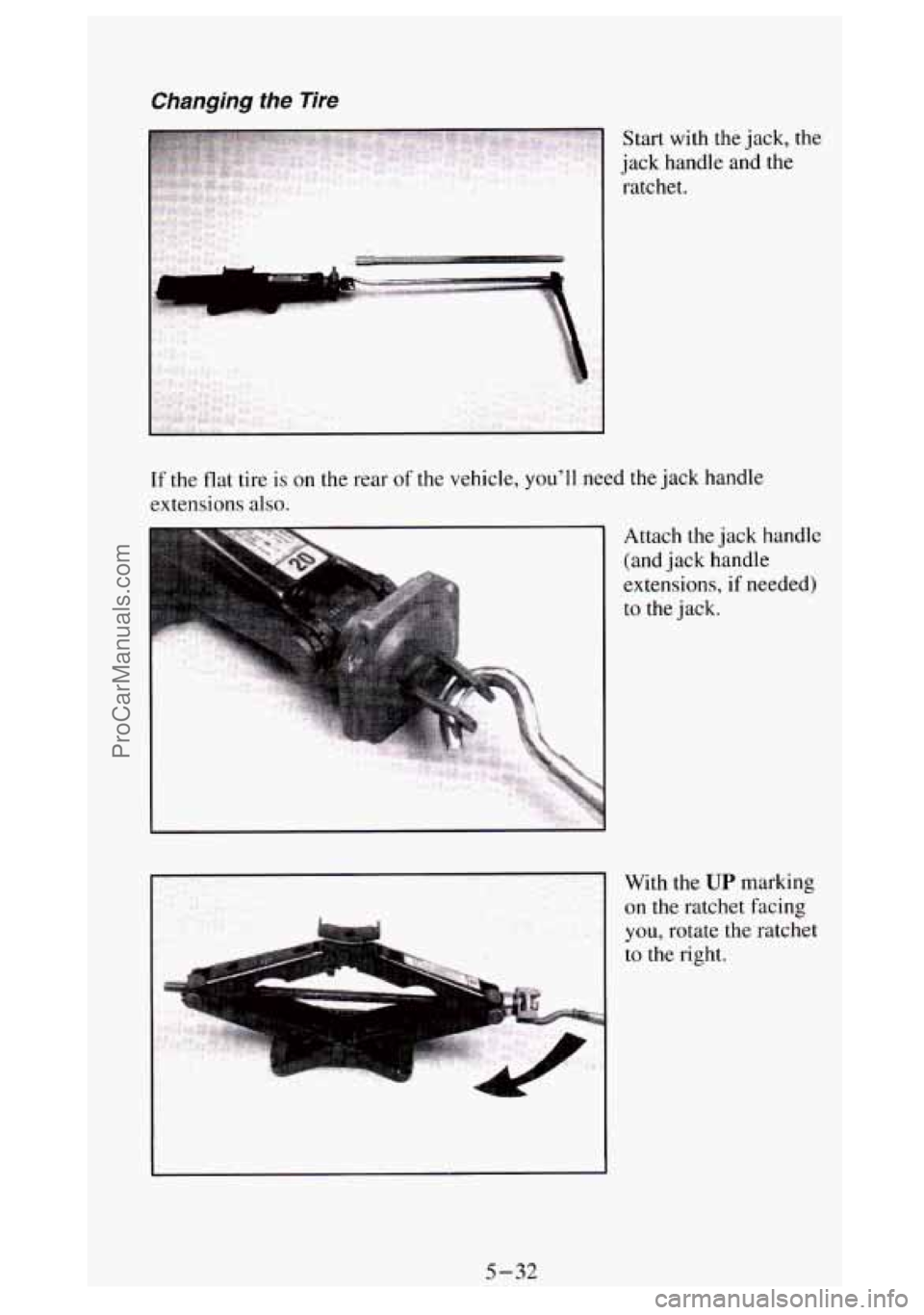GMC SIERRA 1994 Owners Manual
Manufacturer: GMC, Model Year: 1994,
Model line: SIERRA,
Model: GMC SIERRA 1994
Pages: 404, PDF Size: 20.91 MB
GMC SIERRA 1994 Owners Manual
SIERRA 1994
GMC
GMC
https://www.carmanualsonline.info/img/44/57858/w960_57858-0.png
GMC SIERRA 1994 Owners Manual
Trending: maintenance, catalytic converter, odometer, wheelbase, engine overheat, check engine light, oil level
Page 231 of 404
1. You can remove the coolant surge tank pressure cap when the coolin\
g
system, including the coolant surge tank pressure cap and upper\
radiator hose, is no longer hot.
I
Turn the pressure cap slowly to the left until it first stops. (Don't press
down while turning the pressure cap.)
If you hear a hiss, wait for that to stop. A hiss means there is still some
pressure left.
2. Then keep
turning the cap,
but now push down as
you turn
it. Remove the
pressure cap.
5-23
ProCarManuals.com
Page 232 of 404
3. Open the air
bleed valve
located on the
thermostat
housing.
4. Fill the coolant
surge tank with
the proper mix,
up to the
COLD
mark.
While filling the surge tank, watch to see
if coolant begins to stream
out the air bleed valve. When coolant begins to stream out, close the
valve.
>. _:
5. With the air bleed
valve closed and
the coolant surge
tank pressure cap
off, start the
engine and let it
run until
you can
feel the upper
radiator hose getting hot.
Watch out for the
engine fan(s).
5-24
ProCarManuals.com
Page 233 of 404
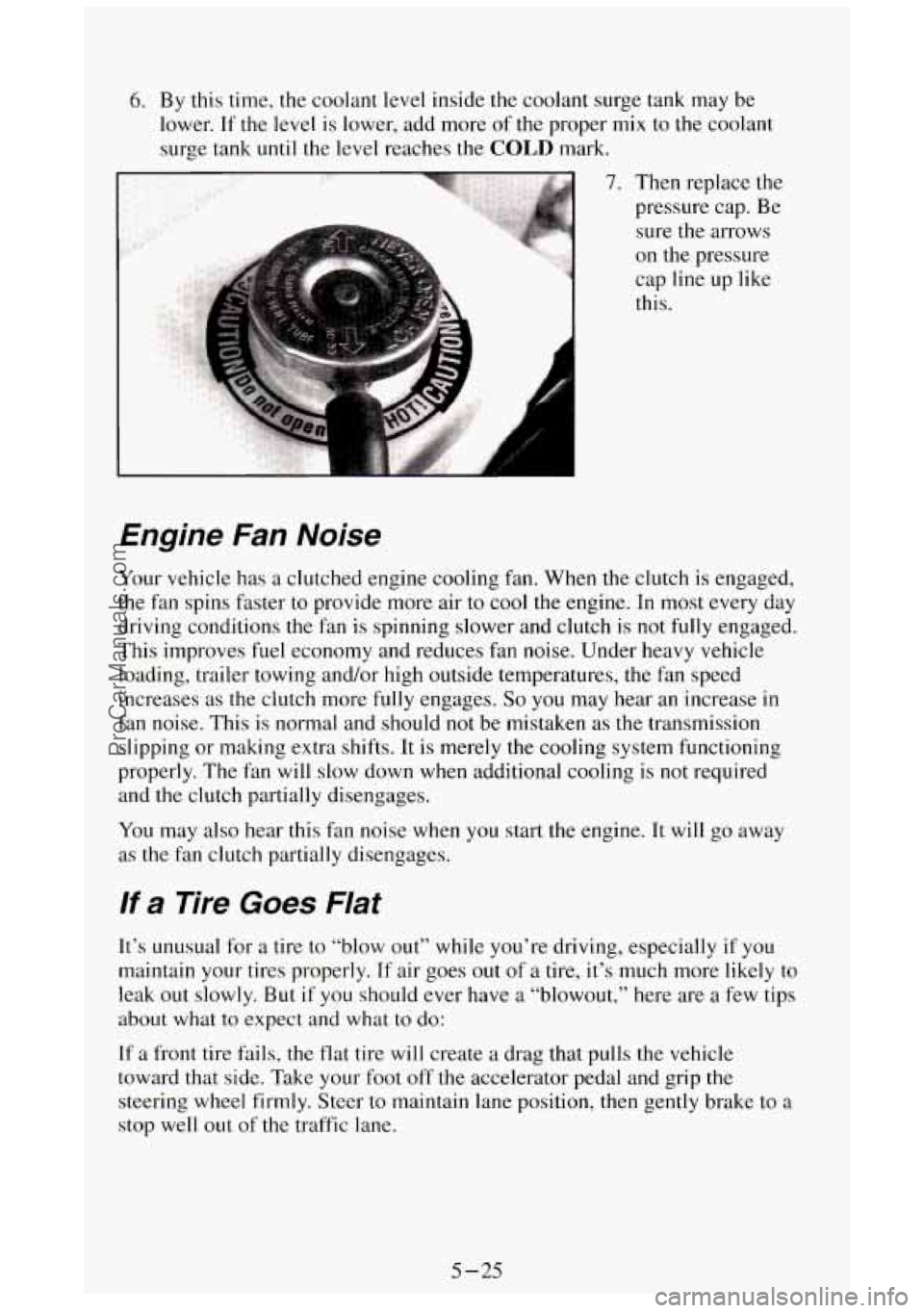
..I . ... . ;. ..
Engine Fan Noise
Your vehicle has a clutched engine cooling fan. When the clutch is engaged,
the fan spins faster
to provide more air to cool the engine. In most every day
driving conditions
the fan is spinning slower and clutch is not fully engaged.
This improves fuel economy and reduces fan noise. Under heavy vehicle
loading, trailer towing and/or high outside temperatures, the fan speed
increases as
the clutch more fully engages. So you may hear an increase in
fan noise. This is normal and should not be mistaken as the transmission
slipping or making extra shifts. It is merely the cooling system functioning
properly. The fan will slow down when additional cooling is not required
and
the clutch partially disengages.
You may also hear
this fan noise when you start the engine. It will go away
as
the fan clutch partially disengages.
If a Tire Goes Flat
It’s UfluSual for a tire to “blow out” while you’re driving, especially if you
maintain your tires properly. If air goes out of a tire, it’s much more likely to
leak
out slowly. But if you should ever have a “blowout,’’ here are a few tips
about what
to expect and what to do:
If a front tire fails, the flat tire will create a drag that pulls the vehicle
toward that side. Take your foot off
the accelerator pedal and grip the
steering wheel firmly. Steer to maintain lane position, then gently brake to a
stop well
out of the traffic lane.
5-25
ProCarManuals.com
Page 234 of 404
A rear blowout, particularly on a curve, acts much like a skid and may
require the same correction you’d use in
a skid. In any rear blowout, remove
your foot from the accelerator pedal. Get
the vehicle under control by
steering the way you want the vehicle to go. It may be very bumpy and
noisy, but you can still steer. Gently brake to a stop, well \
off the road if
possible.
If a tire goes flat, the next section shows how to use your jac\
king equipment
to change a flat tire safely.
Changing a Flat Tire
If a tire goes flat, avoid further tire and wheel damage by driving slowly to a
level place. Turn
on your hazard warning flashers.
5-26
t
ProCarManuals.com
Page 235 of 404
use the jack and
change a tire.
L Blocked Tire
1 ne equipment you’ll need is behind the passenger’s seat. Your spare tire is
stowed under the truck or mounted to the inside of the truck bed on the
driver’s side.
Jacking Tool Storage- Two and Four Door Models
1. Nut
2. Jack
3. Jack Handle Extension
4. Socket
5. Jack and Tool Storage Box
6. Ratchet
7. Jack Handle
8. Tool Retainer
5-27
ProCarManuals.com
Page 236 of 404
Jacking Tool Storage- Extended Cab Models
3
1. Nut
2. Jack and Tool Cover
3. Jack Handle Extension
4. Tool Retainer
5. Jack and Tool Storage Box
6. Ratchet
7. Socket
8. Jack
9. Jack Handle
Jacking Tool Storage- Chassis Cab Models
1. Nut
2. Jack Handle Extension
3. Socket
4. Jack and Tool Storage Box
5. Ratchet
6. Jack Handle
7. Tool Retainer
8. Jack
5-28
ProCarManuals.com
Page 237 of 404
Jack Storage
Your jack and wheel ratchet are behind the passenger seat. Turn the wing
nut to the left and remove the cover if there is one.
Spare Tire Storage-Underbody Carrier
Remember, never remove or restow a tire from or to a stowage position
under the vehicle while the vehicle is supported only by a
jack.
Spare Tire
Your spare tire may be
mounted underneath
the rear
of the vehicle,
OR;
it may be mounted to
the inside
of the truck
bed on the driver’s
side.
If you have a chassis cab, refer to the information from the body
supplier/installer.
The spare tire is
a full size tire, like the other tires on your vehicle.
5-29
ProCarManuals.com
Page 238 of 404
To Remove the Spare Tire
UP Marking
The ratchet has an UP and a DOWN marking.
Attach the ratchet,
with the
DOWN
marking facing you, to
the wheel wrench.
Put the chisel end of the wheel wrench on an angle through the hole in the
rear
bumper. Be sure the wheel wrench connects into the hoist shaft.
5-30
ProCarManuals.com
Page 239 of 404
from under the
vehicle.
When the tire has
been lowered, tilt the
retainer at the end of
the cable and pull it
through the wheel
opening.
Pickup Bed Mounting
To remove a pickup bed mounted spare tire:
Turn the nut to
the left until it
comes
off.
Pull the tire off
the bolt and
remove it from
the bed.
5-31
ProCarManuals.com
Page 240 of 404
Changing the Tire
Start with the jack, the
jack handle and the
ratchet.
If the flat tire is on the rear of the vehicle, you'll need the jack handle
extensions
also.
I
Attach the jack handle
(and jack handle
extensions,
if needed)
to the jack.
With the
UP marking
on the ratchet facing
you, rotate the ratchet
to
the right.
5-32
ProCarManuals.com
Trending: phone, torque, change language, check engine light, cooling, glove box, wheel bolts
